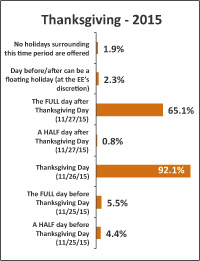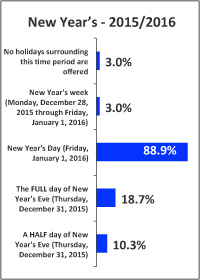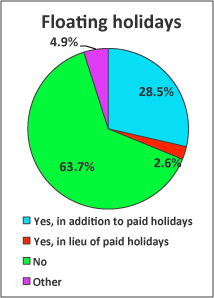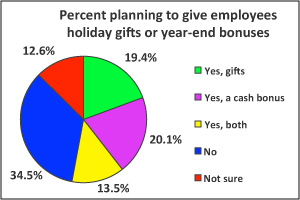 |
Thanksgiving
When asked which days will be paid holidays for employees for Thanksgiving 2015, 92.1% of survey participants indicated that Thanksgiving Day was a paid holiday. Additionally, 65.1% provided a paid day off on the day after Thanksgiving, and 0.8% provided a paid half-day off. A full day off before Thanksgiving was a paid holiday as well for 5.5%, and 4.4% provided it as a half day off with pay. Employees were allowed to use the day before or after Thanksgiving as a floating paid holiday for 2.3% of respondents.

Christmas
For the 2015 Christmas season, 92.4% of survey respondents provided December 25th as a paid holiday for their employees. Christmas Eve was a paid holiday for employees for 41.5%, and it was a half day off with pay for 16.1%. Boxing Day, December 26th, was a paid holiday for 1.6% and a half day for 0.4%, which is not surprising since it fell on a Saturday in 2015.
Christmas week is a paid vacation for 1.1% of survey participants and, from Christmas Eve until New Year’s Day, was offered as paid time off (PTO) for 3.7%. Much like Thanksgiving, the day before or after Christmas could be used as a floating holiday for 3.3%. No PTO for the holiday was offered by 1.9% of survey participants in 2015.
Is your employee handbook compliant? Find out on Friday, February 5, 2016, with a new interactive webinar—Employee Handbooks: Key Updates, Drafting Tips, and Enforcement Advice for 2016. Learn More
New Year’s

In 2014, 87.2% of survey participants offered New Year’s Day as a paid holiday, and 2015 painted a similar picture with 88.9% offering it to their employees. New Year’s Eve was provided as a paid holiday by 18.7%, and 10.3% provided it as a half day off with pay. Down slightly from 2014 (3.5%), 3% provided New Year’s week (Monday, December 28, through Friday, January 8) as PTO for employees. No PTO surrounding New Year’s was provided to exempt employees by 3%.
2016 Holidays
How Many Holidays?
When asked if the number of paid holidays provided in 2016 will be the same as in 2015, 96.2% indicated that it is. Here’s the rundown on how many paid holidays employees will receive in 2016:
- 4.3% of survey participants indicated their employees will receive 1–5 days.
- 38.1% will receive 6–8 paid holidays.
- 43.7% will receive 9–11 days.
- 11.6% will receive 12 or more paid holidays.
- 0.4% will not receive paid holidays in 2016.
- 1.8% will allow employees to use PTO to celebrate holidays.

In addition to paid company-wide holidays, 28.5% will provide paid floating holidays to be used at employees’ discretion. Of those, 35% will provide one floating holiday, 24.7% will provide two, 11.9% will provide three, and 9.2% will provide more than three floating holidays.
Which Holidays?
Like last year, six holidays—Memorial Day, Independence Day, Labor Day, Thanksgiving Day, Christmas Day, and New Year’s Day—will be offered as paid holidays by at least 93% of survey participants in 2016.
Martin Luther King Jr. Day and Presidents’ Day will be paid holidays for 32.6% of respondents and 33.9% of respondents, respectively. Columbus Day is a paid day off for 14.4%, and Good Friday will qualify as a paid holiday for 27.3%. Veteran’s Day will be a paid holiday for 21.5%, and employees’ birthdays will be a paid day off for 6.5%.
Unpaid Holidays

No unpaid holidays will be allowed in 2016 for 61.9%. Election Day, though, will be an unpaid holiday for 27.6%, and for 26.4%, employees can have their birthday off without pay. Employees can, however, use vacation or PTO to cover their pay for 79.8%.
Holiday Pay
Nonexempt employees do not work on holidays for 21.1% of survey participants. The nonexempt employees that do work on holidays, however, receive holiday pay plus time and a half for hours worked for 9.8% of participants, and 2.9% pay holiday pay plus double time. Only regular pay is received for 20.3%, and a different day off with pay is the norm for 4.8%. When it comes to holiday pay for employees that have an unexcused absence on the nearest workday before or after a company paid holiday, 58.2% of survey participants do not provide holiday pay.
First Dibs

When it comes to deciding which employees get priority in deciding their days off during the holidays, 16.8% leave it up to the supervisor, and 12.3% go with whoever asks first. It’s not a problem, and everyone gets what he or she wants for 3.4%, and for 3.4%, employees take turns from year to year. A formal system based on seniority is in place for 6.7%, and 7.2% use an informal seniority/ranking system. The business is closed for 32.1%.
Want to make sure that your employee handbook works? Join us Friday, February 5, 2016, for a new interactive webinar, Employee Handbooks: Key Updates, Drafting Tips, and Enforcement Advice for 2016. Earn 1.5 hours in HRCI Recertification Credit and 1.5 hours in SHRM Professional Development Credit. Register Now
Unrecognized Holidays
For 39.7% of survey participants, less than 5% of their employees use PTO for religious days not recognized by the organization as paid holidays. On the flip side, no employees use such time for 18.8%.
Holiday Gifts
Regarding holiday gifts, a cash bonus is planned for employees by 20.1%, gifts are planned by 19.4%, and 13.5% offered both to their employees in 2015. The gifts include:
- Holiday meal provided either at work or at a company-hosted party off-site, 32.7%;
- “Take-home” holiday meal such as a ham or turkey, 8.7%;
- Grocery store gift card, 13.4%;
- Other gift card (e.g., gas card, prepaid debit, retail store), 15%;
- Extra PTO awarded, 0.8%;
- Door prize or raffle giveaways, 5.7%;
- Personal gifts, 5.5%.
At 18.3%, the “other” basket contained many comments, including the following:
- On-site holiday catered luncheon provided for all; games for raffling of big prizes (two 56” flat screens, one each of newest game consoles, a high-tech camera, plus a few others of owner’s choice; most members of management and senior staff received a small cash bonus of varying amounts on the last check of the year.)
- In lieu of giving gifts to one another, we vote on a needy organization and individuals donate as a “staff gift” to a needy organization.
- Gift item with company logo.
- Holiday lunch at work with door prizes, gift cards, and free days off.
- We give a holiday meal in-house as well as a turkey to take home at Christmas. And, we give a holiday meal in-house and a pumpkin pie to take home at Thanksgiving.
- Department heads are given a budget of an equal dollar amount for each staff member. They may choose to do a team event or to give each person a gift card.

Bonus amounts are varied, with 11% planning 1%–5% of base pay, and 4.3% planning 6%–10% of base pay. A lump sum of up to $250 is planned for 12.5%, a sum of $251–$500 is planned for 5.3%, and 3.2% plan cash bonuses of $500–$1,000. Another 3.9% plan bonuses of $1,000–$5,000.

Employee gift exchange is allowed at 86.9% of survey participants’ organizations. Only gifts of nominal value may be accepted by employees from parties outside their organization (e.g., vendors, clients, etc.) for 41.9%. No employee gift policy is the norm for 20.8%, and “No gifts may be accepted” is the rule for 14.2%. For 22.9%, employees may not accept personal gifts from parties outside the organization but may accept gifts that can be shared with other employees. Also, 4.6% allow gifts that can be entered into an employee raffle. All gifts must be reported to the company for 17.1%, though only if valued over a certain dollar amount for 30%.
Tomorrow, more results from the survey, plus an introduction to an interactive webinar, Employee Handbooks: Key Updates, Drafting Tips, and Enforcement Advice for 2016.
